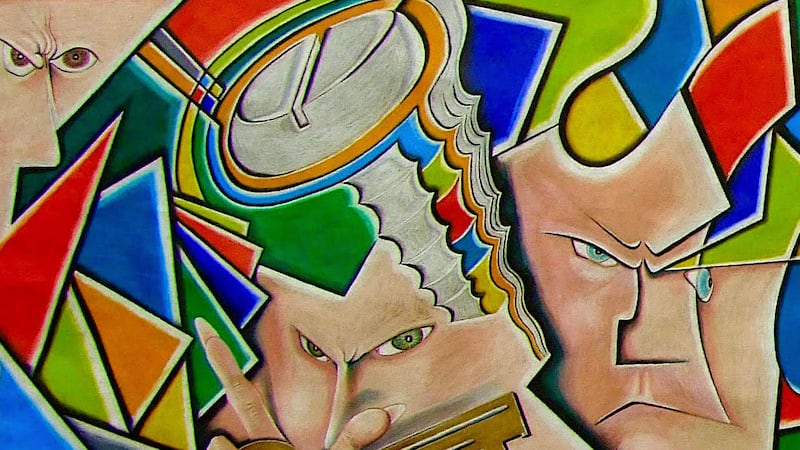At the First Thursday reception for Human Being, three key people were missing from the crowd of over 500 attendees—the artists. David Drenth, Jerome Sloan and the artist known as B. Pat won’t get to see their work while it’s on display at Gallery 114. They can’t take this momentum of a Pearl District gallery exhibit to pursue their careers because they’re inmates in Oregon correctional facilities.
David Drenth is at the Oregon State Penitentiary, where he received an associate degree of arts through Chemeketa’s OSP program (a program that recently got cut). Drenth’s illustrations are works of colored pencil and pastels, with colorful cubist backgrounds broken up with metal bars and gears that blend into menacing faces holding keys.
“I want people to look at the bright side of things. I’ve had terrible things happen in my life, but maybe my art can help people look at a person differently,” said Drenth, calling from OSP. “It’s very limiting with the supplies and size of my cell, I’d love to get out of here and be able to work with acrylics, oils and even metal sculptures.”
David Slader, the member of the co-op gallery that curated this exhibit, was first exposed to inmate art as a defense attorney in Chicago, when a client paid him for post-conviction work with art. (Slader's own works, a collection of female forms in expressionist gestures of teal and magenta, are also displayed in Human Being.) Many inmates pick up a pencil to pass the time while incarcerated, and in the case of the three artists shown at Human Being, end up executing a creative vision with skills they never knew they possessed.
Another artist in the exhibit, Jerome Sloan, is serving a life sentence in the Snake River Penitentiary. Sloan is originally from Portland and his art shows his roots in street graffiti and a creative grasp of script. He’s developed a spacelike sense of scale, suspending hyperrealist faces, sometimes his or his nephew’s, in galaxies of clocks and angular lettering from a language he’s made up.
It’s a strange context—these artists wouldn’t have cultivated these skills if they weren’t in prison. But art can only be so much of an escape from the isolation inmates are subjected to, which was made glaringly obvious when attempting to contact the artists for interviews. It costs money for an inmate to dial out and to send an email. Drenth and Sloan were open to being interviewed, but it took three attempts to get my number into the Department of Corrections’ verified directory. Sloan dialed me once, but the line disconnected and he didn’t call again.
The artists’ limitations can also be seen in their art supplies. Drenth uses the paper he uses for wrapping laundry as his canvas. “They can’t order from Blick,” says Slader. “Because most materials are considered contraband; inmates don’t have many options beyond short nubs of colored pencils in the commissary.”
When facing the paintings and mixed-media collages of B. Pat, you can nearly hear roars of anguish. His mediums include M&M pigment mixed with toothpaste, and many of his otherworldly portraits are made on cardboard from a cereal box. He’s saved magazine clippings when he can, using feminine snarls from lipstick advertisements on distorted, clownish faces. There are excerpts from his notebooks, with Jungian musings and elegant analyses of what “life in a cage” does to a human being.
Human Being is a visceral experience. If you’re struck by the show, Drenth has a request: “Please write to my parole officer and tell him my art deserves to be seen.”
SEE IT: Human Being is at Gallery 114, 1100 NW Glisan St., gallery114pdx.com. Through July 31.
